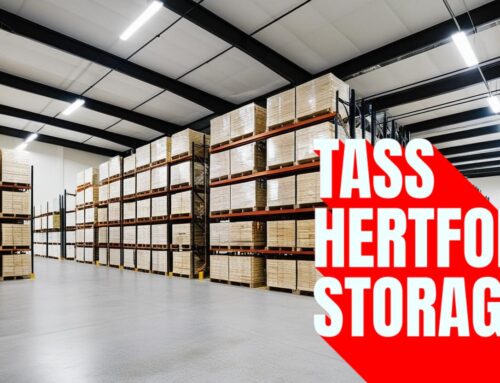When it comes to B2B logistics, the right storage strategy isn’t just about stacking boxes in a warehouse — it’s about creating an efficient, scalable system that supports the flow of goods, reduces costs, and enhances customer service.
Whether you’re a manufacturer, wholesaler, or distributor, storage is a critical part of the supply chain that affects everything from delivery times to operational overheads. In this guide, we’ll explore the key storage strategies in B2B logistics, how to evaluate your business needs, and how to implement a plan that works now — and in the future.
Need help setting up the perfect storage solution for your business? Speak to Brenda at TASS Enterprise today on 01992 511051 or visit www.tasshertford.co.uk.
Why Storage Strategy Matters in B2B Logistics
In B2B logistics, storage isn’t just a backend function—it’s a critical driver of business performance.
Unlike B2C, where customers order smaller quantities, B2B clients demand larger shipments, regular schedules, tighter delivery timelines, and real-time updates. A well-designed storage strategy is essential to meet these expectations and keep operations running smoothly.
The right approach to storage can deliver major benefits, including faster order fulfillment, better inventory control, reduced operational costs, improved cash flow, and stronger client relationships.
By aligning storage with your overall logistics strategy, you can adapt to demand fluctuations, minimise excess inventory, and create a more efficient supply chain. This not only boosts your bottom line but also strengthens your ability to exceed client expectations, building long-term trust and partnerships.
Types of Storage Strategies in B2B Logistics
There’s no one-size-fits-all solution when it comes to storage. The right strategy will depend on your industry, volume, product types, and business goals. Below are the most commonly used storage strategies in B2B logistics:
1. Centralised Storage
This strategy involves storing all products in one primary location. It’s ideal for businesses with a single distribution hub or those shipping to clients across a wide area.
Benefits:
- Lower fixed costs
- Easier inventory management
- Simplified staffing and supervision
Best For: Businesses with national or international clients, or those that require strict inventory control.
2. Decentralised Storage
Products are stored in multiple warehouses closer to key customer locations. This strategy prioritises proximity to improve delivery speed and customer service.
Benefits:
- Faster shipping
- Reduced transportation costs
- Flexibility in handling regional demand
Best For: Brands with regional clients or time-sensitive deliveries.
3. Cross-Docking
In a cross-docking model, incoming goods are unloaded and quickly reloaded onto outbound vehicles — skipping storage entirely. This minimises handling time and speeds up delivery.
Benefits:
- Lower storage costs
- Reduced handling and labor
- Quicker turnaround times
Best For: High-volume, fast-moving products.
4. Just-In-Time (JIT) Storage
JIT focuses on receiving inventory exactly when it’s needed — not before. It reduces the need for large warehouse spaces but requires precise coordination.
Benefits:
- Minimises inventory costs
- Reduces waste and obsolescence
- Increases cash flow
Best For: Manufacturers with reliable supply chains and consistent demand.
5. Dedicated vs. Shared Warehousing
Some businesses opt for dedicated warehouses (exclusive use), while others use shared facilities with multiple clients to split costs.
Dedicated Storage Pros:
- Full control over layout and systems
- Customised processes
Shared Storage Pros:
- Cost-effective
- Scalable and flexible
- Access to shared resources (staff, tech)
At TASS, we offer flexible pallet storage with both dedicated and shared options — perfect for scaling brands without long-term commitments.
How to Choose the Right Storage Strategy: Key Factors to Consider
Choosing the right approach starts with a clear understanding of your business needs. Here are the most important factors to consider when developing a storage strategy:
1. Volume and Velocity of Goods
Are your products high-turnover, or do they sit in storage for weeks or months? Fast-moving goods may benefit from cross-docking or decentralised storage, while slower items might be better in a centralised location.
2. Product Characteristics
Different products have different storage requirements:
- Perishables require temperature control
- Hazardous materials need specific safety measures
- Large, bulky items demand more space and specialist equipment
At TASS, we store everything from nootropic drinks to fashion stock — including temperature-sensitive goods and promotional packs.
3. Client Expectations
B2B clients may have strict SLAs (service-level agreements), requiring fast turnaround, specific delivery windows, or custom packaging. Choose a storage setup that helps you meet (or exceed) those expectations.
4. Geographic Coverage
Where are your clients located? A decentralised approach may be better if you ship to various regions regularly.
5. Technology and Tracking Needs
Advanced systems like Warehouse Management Systems (WMS), RFID, and barcode scanning can improve accuracy and visibility. If your business relies heavily on real-time updates or integrations with platforms like Shopify or Amazon, your storage partner should offer robust tech.
We integrate seamlessly with leading platforms — making inventory and order management effortless for our clients.
Cost Considerations: Storage vs. Efficiency
Cost is an important factor when designing a storage strategy, but the cheapest option isn’t always the most effective. For example, renting a less expensive but poorly located warehouse might save on rent but could lead to higher transport costs and slower delivery times. Balancing upfront savings with long-term operational efficiency is key to finding the right solution for your needs.
When evaluating costs, consider all relevant factors beyond rent. Think about labor expenses, such as on-site staff and handling time, as well as utilities, transport, and fuel. Don’t overlook the importance of technology investments, which can improve efficiency, or the costs associated with shrinkage, damage, and losses.
A smart storage strategy strikes the right balance between cost and performance, ensuring that your operations remain efficient while staying within budget.
Can storage units help businesses save money?
Absolutely. Storage units provide businesses with cost-effective solutions for managing space and resources. By utilising storage units for seasonal inventory, surplus materials, or equipment, businesses can avoid the substantial costs associated with leasing larger office or warehouse spaces. This scalable approach allows companies to adjust their storage needs as required, reducing overhead expenses and improving financial flexibility.
Moreover, organised storage helps safeguard valuable assets by minimising the risk of damage or loss. By freeing up premium workspace for critical operations, businesses can enhance productivity and support growth. Storage units also promote operational efficiency by optimising space utilisation, enabling organisations to focus on core functions.
At TASS, we specialise in managing both ambient and controlled storage, consistently adhering to industry best practices and regulatory standards. By leveraging professional storage solutions, businesses can maintain a cost-effective approach to space management, ultimately driving profitability while ensuring functionality.
How We Care for Our Clients
At TASS Hertford, we proudly support a mix of amasing brands – from local startups to international e-commerce stars. Right now, we’re managing pallet storage, pick and pack, and despatch for GoMate Drinks, UNLTD. Beer, Sakuranna Swimwear, and Nooi Nootropic Drinks, just to name a few!
Our clients trust us because we do more than logistics – we deliver peace of mind. We’ll take the time to get to know your brand’s needs and tailor our service to fit perfectly. Whether it’s creating custom influencer gift packs, storing temperature-sensitive stock, or fulfilling those last-minute orders, our small, dedicated team always goes the extra mile.
We’d love to help your business! Chat with our friendly team by calling 01992 511051 or visit www.tasshertford.co.uk.
Tass Hertford Offer More Than Just Storage Strategy
Think we only do Storage Strategy? Think again! For over 20 years, we’ve been proudly supporting businesses in Hertfordshire and across the UK. And in that time, we’ve grown way beyond pallet storage. Here’s everything we can do for you:
- Pallet storage – secure, affordable, and flexible with short- or long-term options
- Pick, pack, and despatch – fast, accurate, and ready to scale when you grow
- E-commerce fulfilment – seamless integration with Shopify, Squarespace, Amazon FBA, TikTok Shop, and more
- Contract packing – bespoke services like Christmas packing, gift hampers, and subscription boxes
- Influencer gifting – branded boxes, hand-wrapped gifts, handwritten notes, and more
- Container unloading, palletising, and depalletising
- Food and drink logistics – designed for snack brands, supplement brands, and breweries
- Worldwide shipping – fast and cost-effective, whether it’s local or global
- Business storage – for stock, documents, or equipment, with no long contracts
- Office space and hot desking – beautiful workspaces with garden views, kitchen access, and parking
Ready to make your logistics easier? Let’s chat! Call us at 01992 511051 or visit www.tasshertford.co.uk.
Tips for an Effective Storage Strategy
Here are some practical steps for implementing a successful B2B storage strategy:
Audit Your Current System
Conduct a thorough assessment of your existing processes to determine what is functioning well and where improvements are needed. Identify bottlenecks, excessive costs, or customer concerns linked to fulfillment and storage operations.
Define Your KPIs
Establish clear, measurable objectives to guide your progress. Focus on goals such as reducing delivery times, minimising storage expenses, or increasing inventory accuracy.
Choose the Right Partner
Select a storage partner who can seamlessly integrate with your team and operations. Prioritise providers with proven expertise, adaptability, and a strong track record of excellent service.
Prioritise Integration
Ensure your storage provider can connect effectively with your order management systems, inventory tools, and sales platforms to streamline operations.
Plan for Growth
Design your storage strategy with scalability in mind. Accommodate future business needs, such as increased SKUs, higher order volumes, or market expansion into new regions.
We are here to support your growth with tailored, scalable solutions. Learn more at www.tasshertford.co.uk.
FAQs
How does inventory storage impact customer satisfaction in B2B fulfilment?
Proper inventory storage ensures accurate stock levels and fast order processing, which directly helps improve customer satisfaction. In B2B fulfilment, meeting customer expectations through reliable stock availability and timely deliveries is essential for maintaining trust.
Why is inventory tracking vital for effective supply chain management?
Accurate inventory tracking helps maintain optimal inventory levels, reduces errors, and supports timely deliveries. In effective supply chain management, this visibility allows businesses to respond quickly to demand, keeping the fulfilment process smooth and efficient.
Can automated systems give a competitive edge in B2B logistics?
Yes, automated systems enhance inventory tracking, streamline order processing, and lower delivery costs. This improves overall efficiency and offers a competitive edge in both B2B fulfilment and business to consumer models by ensuring consistent performance.
What role does the storage strategy play in customer satisfaction?
A well-planned storage strategy supports quick access to stock, faster order processing, and fewer mistakes. In turn, this helps improve customer satisfaction by aligning operations with rising customer expectations in the B2B logistics space.
Conclusion
The right storage strategy is more than just a logistics decision — it’s a competitive advantage. Whether you’re launching a new product, scaling your supply chain, or just trying to improve delivery times, a tailored storage solution is key.
By understanding your inventory, customers, and operational needs, you can create a system that’s efficient, flexible, and built for growth. And by working with the right partner, you’ll save time, reduce risk, and keep your B2B clients happy — every single time.
Ready to rethink your storage strategy? Speak to Brenda today on 01992 511051 or visit www.tasshertford.co.uk. Let’s build a smarter logistics future together.











